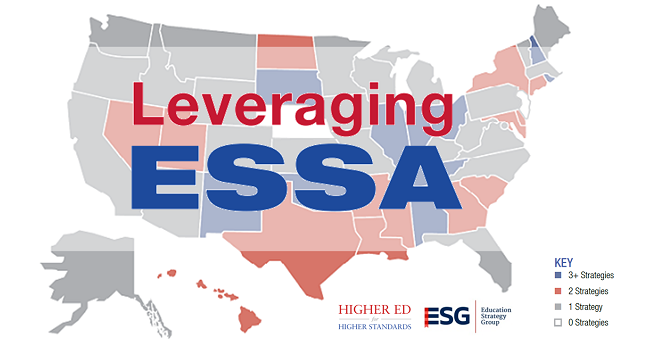K–12 and Higher Education Alignment – No Time Like the Present

ESSA presented a vital opportunity for K–12 and higher education collaboration to make college and career readiness a clear priority and build seamless postsecondary transitions. After reviewing ESSA plans from all 50 states and the District of Columbia, states have taken advantage of this opportunity to double down on alignment for student success — to varying degrees. Going forward, true success will now be determined by how states execute their planned alignment strategies.
Considered “an early Christmas present,” then-President Obama signed the Every Student Succeeds Act into law in mid-December of 2015. This replacement to No Child Left Behind represented a distinct change: the federal government was putting states in the driver’s seat to close equity gaps and help all students demonstrate college and career readiness. Our latest policy brief, Shining a Spotlight on K–12 and Higher Education Alignment in ESSA, looks across state plans to date around four key K-12 and higher education alignment strategies: high-quality standards and assessments, vertically aligned goals, high school accountability, and postsecondary student transitions.
Overall, forty-eight states and the District of Columbia included at least one of our recommended K–12/ higher education alignment strategies, while ten states demonstrated significant alignment by including three or more of the recommended strategies. These states can and should serve as a model for others seeking to build and expand activities that align K-12 and postsecondary systems to close equity gaps and improve the earning potential of our citizens. Below is a quick overview, presented in more detail in our most recent brief, of where states incorporated strategies for alignment:
- Validating college-ready standards and aligned assessments: ESSA required align K–12 academic content and achievement standards with the entrance requirements for credit-bearing coursework in the state’s system of public higher education, yet only three states included information about higher education’s involvement in the creation or validation of high-quality standards and assessments in their plans. Going forward, states should continue to include higher education in any process to review or revise standards and assessments, and consider creating a policy across public institutions to high school assessments as evidence of readiness for credit-bearing coursework. For more information about this issue, see Aligning Expectations: Partnering with K–12 To Ensure College Readiness.
- Vertically aligning K–12 and higher education goals: Almost all plans presented a ‘college- and career-readiness for all’ vision, but 17 states made a direct connection from their long-term K–12 goals in ESSA to their higher education attainment goal. Since nearly 40 states have set postsecondary attainment goals, all states should confirm that the trajectory of the state’s long-term K–12 goals will meet its postsecondary attainment goal, back mapping annual targets from goal to current benchmark, and also consider developing public annual targets for each school, district, and higher education institution in the state to make the goals tangible. For more information, see Aligning K–12 and Higher Education Goals To Support Success for All Students.
- Supporting student transitions into postsecondary: Twenty-three states identified specific strategies or funding to support students’ preparation for higher education, often through expanded access to early postsecondary options while in high school. Many states plan to offer subsidies or supports for advanced coursework, including AP/IB courses or dual enrollment/credit, as well as college and career guidance opportunities. As states move into implementation, they should develop and scale “catch up” courses for those who have not yet demonstrated college readiness, to complement the expanded early postsecondary courses. Our brief on Strategies To Support Student K–12 to Postsecondary Transitions can provide additional information.
- Holding schools accountable for college and career preparation: Forty-one states included a college- and career-ready indicator in their high school accountability system, with an additional six planning to include a college- and career-ready indicator in the near future or in a separate state accountability system. States largely proposed that these measures would account for between 5 and 30 percent of a high school’s overall rating. As states implement these new accountability indicators, they should build user-friendly public reporting tools focused on students’ college and career readiness as well as postsecondary transitions without the need for remediation. Additional opportunities for research during implementation include quantifying access to early postsecondary opportunities and confirming that the state’s chosen college and career readiness indicators are truly predictive of postsecondary entry and success. For more information, see our joint report with CCSSO, Destination Known: Valuing College and Career Readiness in State Accountability Systems.
In addition to these K-12 and higher education alignment recommendations, our team has reviewed ESSA plans to highlight opportunities to improve student success through career readiness and accountability levers. While state ESSA plans represent an important opportunity to build and strengthen K–12 and higher education partnerships, they’re just one possible vehicle to bring about these changes. Working together, K–12 and higher education can deliver an education system that closes equity gaps, improves the earning potential of our citizens and allows our states to cultivate a robust workforce, capable of sustaining and building a 21st century economy. Just as early Christmas presents give way to New Year’s resolutions, the real work must begin now, as states work to implement the work in the ESSA plans to reach the goals they’ve set for themselves.



